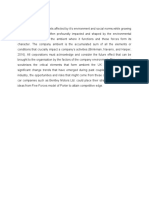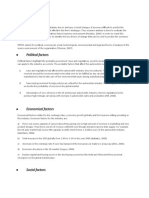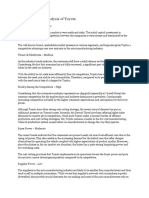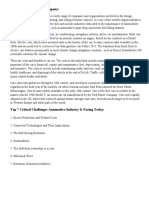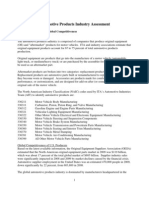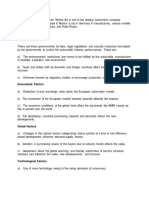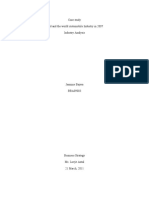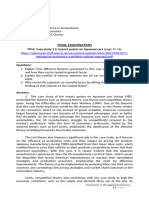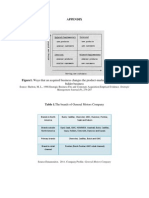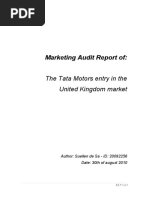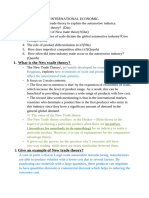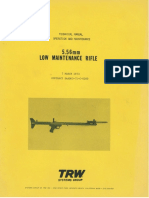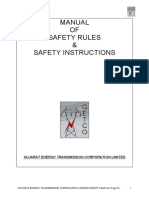SFDSDFSDFSDFSDFSDF
SFDSDFSDFSDFSDFSDF
Uploaded by
Sheikh Siddique HafizCopyright:
Available Formats
SFDSDFSDFSDFSDFSDF
SFDSDFSDFSDFSDFSDF
Uploaded by
Sheikh Siddique HafizOriginal Title
Copyright
Available Formats
Share this document
Did you find this document useful?
Is this content inappropriate?
Copyright:
Available Formats
SFDSDFSDFSDFSDFSDF
SFDSDFSDFSDFSDFSDF
Uploaded by
Sheikh Siddique HafizCopyright:
Available Formats
Every organization or a firm need and possess certain resources and competences required to
endure and thrive globally. In other words every firm has its own strategic capability to survive
against all odds (Gerry Jonhson, Kewan Scholes, Richard Whittington, 2008).
The resources consist of-
Tangible resources underlining the physical chattels like plant, people and finance of
the organization
Intangible resources underlining non-physical chattels like information, reputation and
knowledge (Gerry Johnson, Kevin Scholes, Richard Whittington, 2008)
Resources based analysis of BMW:
Political factors
Political factors highlight the probable government laws and regulations, security measures and
restrictions that can apply to the industry as a whole. The probable factors that affect the
automobile industry are:
1. Laws and regulations had affected the automobile industry since its outburst. These laws
generally revolved around the environmental norms that were to be fulfilled by any car industry.
Thus the car manufacturers had to take care of the environmental issues during manufacturing
of cars.
2. Taxes and government foreign policies are critical for the automobile industry. The foreign
policies help to us decide the probability of success in the global market.
3. Introduction of new schemes in the US and Europe automobile industry wherein regulations led
to produce high mileage cars along with increase in automobile sales and production (Hill,
2008).
Economical factors
Economical factors related to the exchange rates, economic growth globally and the business
setting prevailing in the industry. Economic factors for the industry are:
a) There was excess capacity of cars produced thus giving rise to high amount of revenue in
marketing and new product designs. Thus there was lot of revenue withheld even though demand
was less than supply. For example the UK auto market had excess 80% capacity in 2003 which
freeze 1.3 billion euro of the automobile industry (autofacts, 2004).
b) Total increase in the GDP globally from 2.0% to 3.1% in the year 2008 (statistics, 2008).
c) Decrease in the exchange rate if euro has hampered the European car makers in a big way
(Allen, 2006).
d) Economic downturn in the US market (Copper, 2008)
e) Surplus capital and buying power in the developing economies like India and China and
their personal emergence in the global market place.
Social factors
Social factors include the changes in cultures and demo graphics globally apart from change in
buying pattern and capacity of the consumer. Social factors having an impact on the auto
industry are:
Changes in the customer predilection from car being a status symbol to fuel efficiency and low
emission cars.
Changes in buying pattern of the consumers due to recession in mature markets.
Environmental issues and awareness of the harmful emissions through automobiles
Technological factors
o Increase in use of technology to gain a clear competitive ad vantage
o Use of new and sophisticated design to overcome the decreased margins in the
industry.
o Modifications or restriction on technology causing environmental pollution
Environmental factors
o Increasing effect if awareness of global warning, greenhouse effect and burnout among
patrons (organization, 2008)
o Shift in consumers tastes and preferences towards use of more eco-friendly cars, hybrid
cars, fuel cell cars etc.
o Stern application of the EURO norms set up to curb pollution in developing countries.
Legal factors
o Restrictions and strict pollution norms set up in European and US markets
o Strict implications of the EURO norms in developing countries e,g, formation of BHARAT
norms on the lines of EURO norms in India(CEN, 2006)
PORTERS FIVE FORCES ANALYSIS
Threats of new entrants:
Threat of new entrant is dependent on the challenges faces during entry into the industry or
entry barriers. The threat of new entrants in case of automobile industry is less as large capital
cost is required to set up a manufacturing plant and assembly liner. Also it takes time for new
entrants to get a place and the reputation in the minds of the consumers.
Threats of substitutes:
BMW has a brand image of being powerful and luxurious. It is positioned in the exclusive car
range where there exist many substitutes for BMW like mercedes, GM and Toyoto. Thus the
threat of substitutes for BMW is high.
Bargaining power of buyers:
BMW and its competitors are positioned as in exclusive product range. Here the bargaining
power of buyers is high because the consumers can decide the product according to the price
range and buy the products accordingly. Also with environmental issues hovering over the
industry the buyers have the last say with sample substitutes available.
Bargaining power of suppliers:
BMW has good supply chain management system and had long relationship with suppliers. The
bargaining power of suppliers is high in this industry as the suppliers can dedicate the price tag
for the raw materials. Though long time associations with suppliers can prove fruitful, the final
word lies more or less with the suppliers.
Competitive rivalry
Industry has cut thoat comptetion for its products, with its products targeting the segment and
postioned in a similar way. Competitive rivalry was high in the industry with the dominant US
and European markets facing stiff competition from the Asian market.
You might also like
- Master Slave ContractDocument8 pagesMaster Slave Contractpelaku fantasi100% (7)
- Bentley Motors Limited ReportDocument11 pagesBentley Motors Limited ReportSayed Abdul Wajed0% (1)
- Competitive Analysis of VolvoDocument4 pagesCompetitive Analysis of VolvoMarketing Xiss0% (1)
- Operations Management in Automotive Industries: From Industrial Strategies to Production Resources Management, Through the Industrialization Process and Supply Chain to Pursue Value CreationFrom EverandOperations Management in Automotive Industries: From Industrial Strategies to Production Resources Management, Through the Industrialization Process and Supply Chain to Pursue Value CreationNo ratings yet
- Business Strategy Assignment 1Document25 pagesBusiness Strategy Assignment 1moveonman78% (18)
- Ford and World Automobile IndustryDocument6 pagesFord and World Automobile IndustrySahoo SK100% (1)
- Quality Enhancement in Voluntary Carbon Markets: Opening up for MainstreamFrom EverandQuality Enhancement in Voluntary Carbon Markets: Opening up for MainstreamNo ratings yet
- RFID at MetroDocument5 pagesRFID at MetroSreekanth PS100% (1)
- Drilling Formulae - 9th Edition PDFDocument87 pagesDrilling Formulae - 9th Edition PDFEng Mohamed SaberNo ratings yet
- Strategic Planning - BMW Strategic PlanningDocument26 pagesStrategic Planning - BMW Strategic Planningyasir_irshad100% (4)
- PestelDocument2 pagesPestelgaurangNo ratings yet
- Figure 1 Shows The Organization, Internal Environment and Its FactorsDocument9 pagesFigure 1 Shows The Organization, Internal Environment and Its FactorsNazia AsadNo ratings yet
- Muzaffar Business Environment AssignmentDocument24 pagesMuzaffar Business Environment AssignmentMuzaffar Kcreativez100% (1)
- Analysis of ToyotaDocument16 pagesAnalysis of Toyotalucianobielli_311046No ratings yet
- Tata Motors Market EntryDocument7 pagesTata Motors Market EntryRinku Gaur100% (1)
- Group11 - WAC4 General Motors in 2017Document47 pagesGroup11 - WAC4 General Motors in 2017SGwannaBNo ratings yet
- Automobile Industry in UkDocument4 pagesAutomobile Industry in UkMitali BiswasNo ratings yet
- Decision Making Process ofDocument11 pagesDecision Making Process ofkmkesavanNo ratings yet
- Assignment No - 5Document16 pagesAssignment No - 5anifNo ratings yet
- Porter's 5-Force Analysis of ToyotaDocument9 pagesPorter's 5-Force Analysis of ToyotaBiju MathewsNo ratings yet
- Assignment Hossain Sazzad 67Document11 pagesAssignment Hossain Sazzad 67Sazzad HossainNo ratings yet
- Individual Assignment2Document14 pagesIndividual Assignment2Haya AwanNo ratings yet
- Environmental AnalysisDocument6 pagesEnvironmental AnalysisValliappan MuthiahNo ratings yet
- Hyundai 091124091217 Phpapp02Document62 pagesHyundai 091124091217 Phpapp02mbogadhiNo ratings yet
- Automotive Industry BEDocument17 pagesAutomotive Industry BEshivam prasharNo ratings yet
- Analysing BMW and The Automobiles IndustryDocument9 pagesAnalysing BMW and The Automobiles IndustryShyam_Nair_9667No ratings yet
- Internal and External Analysis of The Automotive IndustryDocument9 pagesInternal and External Analysis of The Automotive IndustryRohit SoniNo ratings yet
- Toyota HybridDocument8 pagesToyota HybridMohammed Omer ElgindiNo ratings yet
- Intraduction of Automobile CompanyDocument4 pagesIntraduction of Automobile CompanyCraft DealNo ratings yet
- Sample Assignment For The Course of International BusinessDocument14 pagesSample Assignment For The Course of International BusinessAnonymous RoAnGpANo ratings yet
- Threat of New Entrants: LOW: Porter's Five Forces and Complementors: The Automobile IndustryDocument3 pagesThreat of New Entrants: LOW: Porter's Five Forces and Complementors: The Automobile IndustryJean Stephany0% (1)
- Automobile IndustryDocument7 pagesAutomobile IndustryPavansut MishraNo ratings yet
- Pestel Analysis Political FactorsDocument4 pagesPestel Analysis Political FactorsPavel ColladoNo ratings yet
- In-Class Assignment - 3: Positive ImpactDocument3 pagesIn-Class Assignment - 3: Positive Impactpreeti56526No ratings yet
- Rezumat Piata AutoDocument9 pagesRezumat Piata AutodlavinutzzaNo ratings yet
- 2014 BCG - Accelerating InnovationDocument20 pages2014 BCG - Accelerating InnovationikhabibullinNo ratings yet
- Case Study Ford and The World Automobile Industry in 2007 Industry AnalysisDocument7 pagesCase Study Ford and The World Automobile Industry in 2007 Industry AnalysisAmanpreet MakkarNo ratings yet
- General Motors Strategic AnalysisDocument11 pagesGeneral Motors Strategic AnalysisAkshey ShuklaNo ratings yet
- Final Exam in Managerial EconomicsDocument6 pagesFinal Exam in Managerial EconomicscaraaatbongNo ratings yet
- Industry Analysis-1Document6 pagesIndustry Analysis-1Khalid SoomroNo ratings yet
- Project On Financial Analysis of Toyota Motor CorporationDocument66 pagesProject On Financial Analysis of Toyota Motor CorporationSaiRam94% (18)
- Am10 GhosalDocument20 pagesAm10 GhosalpryagilNo ratings yet
- Swot SridharDocument6 pagesSwot SridhararunspeakerNo ratings yet
- ToyotaDocument29 pagesToyotagoelankit51No ratings yet
- General Motors Strategic AnalysisDocument11 pagesGeneral Motors Strategic AnalysisMoaz Ibn Tareq100% (1)
- Toyota Strategy MarketingDocument19 pagesToyota Strategy MarketingMuhammad Sajid Saeed96% (23)
- AppxxxxxxxxxxxxDocument3 pagesAppxxxxxxxxxxxxArif TutsakNo ratings yet
- Strategy Management Ford Case Study SolutionsDocument10 pagesStrategy Management Ford Case Study SolutionsUpendra SharmaNo ratings yet
- Strategic ManagementDocument27 pagesStrategic ManagementSantosh ChourpagarNo ratings yet
- MBA-2ND-SEM-EMERGING TECHNOLOGYPROJECT-REPORT - 0012 - DemoDocument5 pagesMBA-2ND-SEM-EMERGING TECHNOLOGYPROJECT-REPORT - 0012 - DemomlatanveersaitNo ratings yet
- ToyotaDocument10 pagesToyotaArun Sanal100% (2)
- Marketing Audit - Tata Motors Case - Suellen de Sá ID 20092256Document21 pagesMarketing Audit - Tata Motors Case - Suellen de Sá ID 20092256Suellen de SáNo ratings yet
- Team 5 Industry PaperDocument23 pagesTeam 5 Industry Paperapi-315687330No ratings yet
- IE PresentationDocument6 pagesIE Presentationduyendh22No ratings yet
- Driving Change: Innovating Sustainability in the Automotive IndustryFrom EverandDriving Change: Innovating Sustainability in the Automotive IndustryNo ratings yet
- Innovation Matters: Competition Policy for the High-Technology EconomyFrom EverandInnovation Matters: Competition Policy for the High-Technology EconomyNo ratings yet
- Enterprise Management Automobile Industry Business Cases: Renault Morocco, Tesla, Hyundai, TATA Motors, Daimler Mobility, ToyotaFrom EverandEnterprise Management Automobile Industry Business Cases: Renault Morocco, Tesla, Hyundai, TATA Motors, Daimler Mobility, ToyotaNo ratings yet
- Enhancing Competitiveness in Small Developing States: Approaches, Tools and PoliciesFrom EverandEnhancing Competitiveness in Small Developing States: Approaches, Tools and PoliciesNo ratings yet
- Solar Powered Agro Industrial Project of Cassava Based Bioethanol Processing UnitFrom EverandSolar Powered Agro Industrial Project of Cassava Based Bioethanol Processing UnitNo ratings yet
- Style GuideDocument1 pageStyle GuideAnonymous OEAjCYOgNo ratings yet
- 2022 Buildbrace Installation ManualDocument40 pages2022 Buildbrace Installation ManualIan Patrick WijayaNo ratings yet
- 2021-Packing List No PH-PL0018 - PH0090 - PH0091 - PH0092 - PH0093 - PH0...Document1 page2021-Packing List No PH-PL0018 - PH0090 - PH0091 - PH0092 - PH0093 - PH0...WO AHNo ratings yet
- Environmental Health Code 2022 Saehc-S-13 Barber and Beauty ShopsDocument6 pagesEnvironmental Health Code 2022 Saehc-S-13 Barber and Beauty ShopsAhmed ShoreemNo ratings yet
- Presentation On INTELDocument14 pagesPresentation On INTELRicha RichaNo ratings yet
- Appointment LetterDocument4 pagesAppointment Lettershani31No ratings yet
- Question Paper For RACDocument2 pagesQuestion Paper For RACSDvidyaNo ratings yet
- Sales & Distribution MGMT 1Document48 pagesSales & Distribution MGMT 1Dr. Milind Narayan DatarNo ratings yet
- Partnership Formation Operation SessionDocument29 pagesPartnership Formation Operation SessionNelmae Jean VegaNo ratings yet
- MT 103 PMLS Lec NotesDocument32 pagesMT 103 PMLS Lec NotesDavid Tobey AnutaNo ratings yet
- Design and Construction of A Wireless We PDFDocument69 pagesDesign and Construction of A Wireless We PDFPeculiar EbhueleNo ratings yet
- ARCOSX Enclosure Y02-177 00-003vaDocument2 pagesARCOSX Enclosure Y02-177 00-003vaDimasNo ratings yet
- Introduction of Library AutomationDocument9 pagesIntroduction of Library AutomationMurad KhanNo ratings yet
- Prevention of Disease & Health PromotionDocument2 pagesPrevention of Disease & Health PromotionGhith WhiuNo ratings yet
- AdmissionletterDocument1 pageAdmissionletterfabiokannavaro532No ratings yet
- 02 Ching Kian Chuan v. CADocument2 pages02 Ching Kian Chuan v. CACarissa Bonifacio100% (3)
- Emona SIGEx For NI ELVISDocument4 pagesEmona SIGEx For NI ELVISHa LuuNo ratings yet
- Technical Manual Operation and Maintenance 5.56mm Low Maintenance Rifle (LMR)Document24 pagesTechnical Manual Operation and Maintenance 5.56mm Low Maintenance Rifle (LMR)C.A. Monroe100% (1)
- Javier V CADocument4 pagesJavier V CAJZ SQNo ratings yet
- SPCL Bank DepositsDocument13 pagesSPCL Bank DepositsJImlan Sahipa IsmaelNo ratings yet
- If QP MembersDocument4 pagesIf QP MembersPilot Pilot380No ratings yet
- 2 +CPU+Mission,+Vision,+and++HistoryDocument27 pages2 +CPU+Mission,+Vision,+and++HistoryGeorge Henry AnotadoNo ratings yet
- APGENCO Safety PolicyDocument82 pagesAPGENCO Safety PolicyRajanbabuNo ratings yet
- Property Release in Favour of PhotographerDocument2 pagesProperty Release in Favour of PhotographerCouple HeartNo ratings yet
- FRM 2018 Lobs PDFDocument52 pagesFRM 2018 Lobs PDFAnonymous gtP37gHONo ratings yet
- Ilovepdf Merged-1Document29 pagesIlovepdf Merged-1sevynNo ratings yet
- Lawsuit Filed by Former NFL Network Production EmployeeDocument10 pagesLawsuit Filed by Former NFL Network Production EmployeeAnthony J. PerezNo ratings yet

